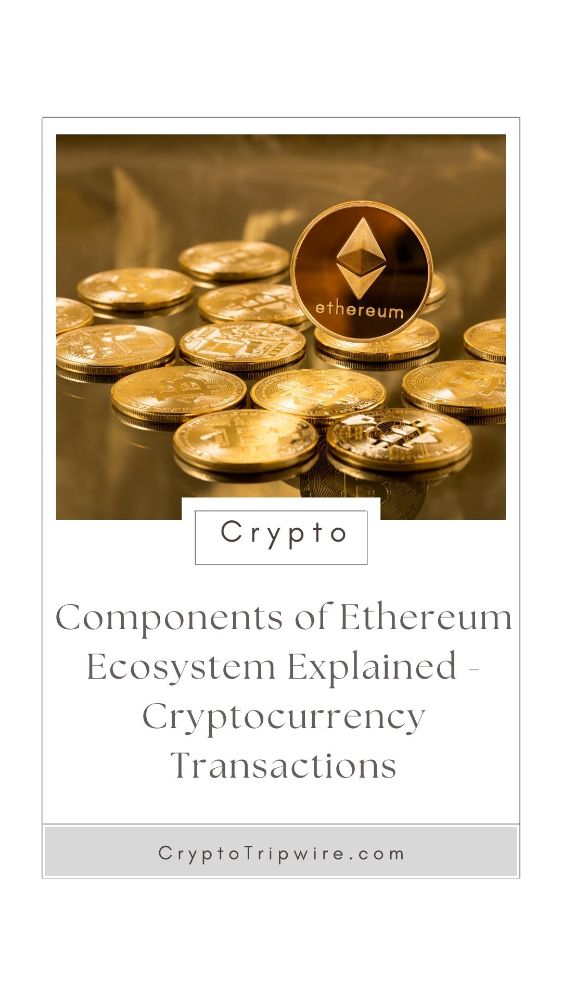Components of Ethereum Ecosystem Explained - Cryptocurrency Transactions
Ethereum is the second-largest cryptocurrency in the world, right behind Bitcoin. However, many beginners in the world of cryptocurrency don’t understand what makes this burgeoning platform work. This guide will break down the key components of Ethereum and explain how this platform utilizes decentralized networks to provide safe, reliable cryptocurrency transactions without a need for third-party intervention.
Components of Ethereum Ecosystem Explained
If you're new to Ethereum, you may be wondering what all the fuss is about. After all, it's just another cryptocurrency, right? Well, not exactly. Ethereum is much more than that. We'll explain the Ethereum ecosystem and how it works. We'll also discuss some of the benefits of using Ethereum over other cryptocurrencies. So if you're curious about Ethereum, read on!
What are Decentralized Networks?
Before we get into the different components of Ethereum, you may be wondering what a decentralized network is. A decentralized network allows users to connect directly, on a peer-to-peer basis, without the supervision of a centralized authority. Each user has access to a distributed ledger, which shows the same recorded data to every member on the network. This data is validated using a consensus mechanism, which typically involves the other members of the network checking the validity of the data before it becomes imprinted onto the blockchain.
Since Ethereum-based data is accessible and readable by every member of the network, users are less susceptible to getting scammed. This has allowed people to create their own tokens, applications, and methods for financing without relying on a centralized authority to validate their authenticity.
What is the Ethereum Ecosystem?
Ethereum refers to the entire ecosystem based on Ethereum. But what is this ecosystem comprised of? The main components of the Ethereum ecosystem are:
- Smart contracts
- The blockchain
- A consensus mechanism
- The EVM – Ethereum Virtual Machine
- Ether tokens
Smart Contracts
Smart contracts are self-executing contractual agreements stored in the blockchain. They allow users to set up a system that governs the interactions between the parties involved in the transaction. Once the defined conditions are met, they self-execute.
Since these contracts exist on the blockchain, they are impossible to tamper with. Therefore, users do not need to trust each other to carry out contractual agreements, nor is a middleman required. Transactions are conducted peer-to-peer, without the need to pay an extra fee to a third party to broker the conditions of the contract.
Blockchain
Like Bitcoin, Ethereum relies on a blockchain to secure its transactions. The blockchain contains the data of all confirmed transactions in chronological order, like a ledger where every activity is recorded. This ledger is publicly available and distributed across a network of computers called “nodes,” which verify and record all transaction and smart contract data.
Ethereum differs from Bitcoin in that its nodes are also responsible for keeping track of Ethereum’s “state.” This refers to the up-to-date information of all applications running on top of the blockchain, such as each user’s balance, all smart contract data, and any changes that are made.
Consensus Mechanism
Ethereum and Bitcoin also utilize a similar approach to validating transactions in that they both use a proof-of-work consensus mechanism. Mining nodes compete to create new blocks, and the winner earns the right to add the next block to the blockchain. This mechanism is kept secure by the fact that 51% of the Ethereum network’s nodes would be needed to defraud the blockchain.
However, Ethereum is planning on upgrading to a proof-of-stake mechanism. This will be performed by validators who have staked their ether to participate. The validators are chosen at random to create blocks, share them, and earn rewards. This type of mechanism would reduce the need for intense computational work and will reportedly use 99.95% less energy than the current proof-of-work mechanism.
EVM
The EVM – Ethereum Virtual Machine – is the system that allows developers to create decentralized applications, known as DApps. Every Ethereum node has its own EVM, and when a user sends a transaction on Ethereum, each node runs the data through its EVM. If all the nodes reach the same outcome, the transaction is approved and recorded on the blockchain.
Ether
Ether (ETH) is Ethereum’s native token. While ether is typically thought of as a cryptocurrency, it is more accurately described as the “gas” of Ethereum. It facilitates every operation on the network and is the driving force behind Ethereum’s processing power.
Ether is stored in two different types of accounts:
- Contract accounts, which hold smart contracts and release ether once the conditions have been met
- Externally owned accounts, which are the standard accounts that allow users to hold and send ether
Final Thoughts
There are several reasons to consider investing in Ethereum as an alternative to Bitcoin. Now that you have more insight into what makes the Ethereum ecosystem work, consider learning more about this popular cryptocurrency network by checking out the other articles on our site.

About Crypto Tripwire:
CryptoTripwire.com is a website that provides the latest news, videos, and information on cryptocurrency. We strive to provide accurate information for all audiences. The team consists of writers who are experts in their fields with years of experience covering crypto-related topics.
Free Online Training Event this Week: Window Of Opportunity - 7 Ways To Make Money With Crypto Right Now Even If You Are Brand New
2022 © Crypto Tripwire
Terms / Privacy Policy / Disclaimer The information provided on this page does not constitute investment advice, financial advice, trading advice, or any other sort of advice and it should not be treated as such.

